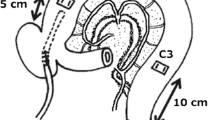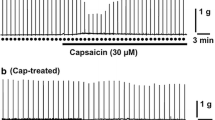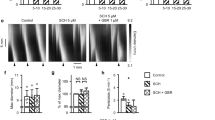Abstract
Purpose
We, herein, examined the role of the intraluminal contents and continuity of colonic intrinsic neurons in intracolonic capsaicin-induced enhancement of colonic motility and defecation.
Methods
Five beagle dogs were equipped with three strain gauge force transducers throughout the colon. The colonic contractile activity in response to intracolonic capsaicin was studied in intact dogs, dogs after colonic cleansing and dogs with transection/re-anastomosis (T/R) between the proximal and middle colon. The effects of intravenous yohimbine, a α2 adrenergic antagonist, on the colonic motility and defecation were also studied in the same models.
Results
In intact dogs, capsaicin (10 mg) and yohimbine (2 mg/kg) immediately induced contractions throughout the colon, with defecation occurring in all experiments. In dogs after colonic cleansing and T/R, the capsaicin (10 mg)-induced enhancement of colonic motility was decreased in the middle and distal colon, and capsaicin-induced defecation was observed in 0–20 % of experiments (p < 0.05 compared to intact dogs). The effect of yohimbine (2 mg/kg) in inducing colonic contractions was unaltered after colonic cleansing and T/R; in contrast, yohimbine-induced defecation was not observed after colonic cleansing, but was unchanged after T/R.
Conclusions
The continuity of the colonic intrinsic nerves as well as the intraluminal contents appear to play an important role in the colonic motor response to intracolonic capsaicin.





Similar content being viewed by others
References
Shibata C, Sasaki I, Naito H, Tsuchiya T, Takahashi M, Ohtani N, et al. Intragastric capsaicin stimulates colonic motility via a neural reflex in conscious dogs. Gastroenterology. 1995;109:1197–205.
Shibata C, Naito H, Ueno T, Jin XL, Funayama Y, Fukushima K, et al. Intraduodenal capsaicin inhibits gastric migrating motor complex via an extrinsic neural reflex in conscious dogs. Neurogastroenterol Motil. 2002;14:543–51.
Shibata C, Jin XL, Naito H, Matsuno S, Sasaki I. Intraileal capsaicin inhibits gastrointestinal contractions via a neural reflex in conscious dogs. Gastroenterology. 2002;123:1904–11.
Hayashi K, Shibata C, Nagao M, Sato M, Kakyo M, Kinouchi M, et al. Intracolonic capsaicin stimulates colonic motility and defecation in conscious dogs. Surgery. 2010;147:789–97.
Holzer P. Capsaicin: cellular targets, mechanism of action, and selectivity for thin sensory neurons. Pharmacol Rev. 1991;43:143–201.
Matsumoto K, Hosoya T, Tashima K, Namiki T, Murayama T, Horie S. Distribution of transient receptor potential vanilloid 1 channel-expressing nerve fibers in mouse rectal and colonic enteric nervous system: relationship to peptidergic and nitrergic neurons. Neuroscience. 2011;172:518–34.
Sarna SK. Effect of fluid perfusion and cleansing on canine colonic motor activity. Am J Physiol. 1992;262:G62–8.
Galligan JJ, Furness JB, Costa M. Migration of the myoelectric complex after interruption of the myenteric plexus: intestinal transection and regeneration of enteric nerves in the guinea pig. Gastroenterology. 1989;97:1135–46.
Shibata C, Sasaki I, Matsuno S, Mizumoto A, Iwanaga Y, Itoh Z. Characterization of colonic motor activity in conscious dogs. J Gastrointest Motil. 1993;5:9–16.
Shibata C, Sasaki I, Matsuno S, Mizumoto A, Itoh Z. Colonic motility in innervated and extrinsically denervated loops in dogs. Gastroenterology. 1991;101:1571–8.
Sarna SK, Condon R, Cowles V. Colonic migrating and nonmigrating motor complexes in dogs. Am J Physiol. 1984;246:G355–60.
Karaus M, Sarna SK. Giant migrating contractions during defecations in the dog colon. Gastroenterology. 1987;92:925–33.
Matsushima Y, Okamoto E, Toyosaka A. Studies on colonic motor correlates of spontaneous defecation in conscious dogs. Jpn J Smooth Muscle Res. 1989;25:137–46.
Nagao M, Shibata C, Funayama Y, Fukushima K, Takahashi K, Jin XL, et al. Role of alpha-2 adrenoceptors in regulation of giant migrating contractions and defecation in conscious dogs. Dig Dis Sci. 2007;52:2204–10.
Doherty NS, Hancock AA. Role of alpha-2 adrenergic receptors in the control of diarrhea and intestinal motility. J Pharmacol Exp Ther. 1983;225:269–74.
Malcom A, Camilleri M. Coloanal motor coordination in association with high-amplitude colonic contractions after pharmacological stimulation. Am J Gastroenterol. 2000;95:715–9.
Iwai N, Kume Y, Kimura O, Ono S, Aoi S, Tsuda T. Effects of herbal medicine Dai-Kenchu-to on anorectal function in children with severe constipation. Eur J Pediatr Surg. 2007;17:115–8.
Sakakibara R, Odaka T, Lui Z, Uchiyama T, Yamaguchi K, Yamaguchi T, et al. Dietary herb extract dai-kenchu-to ameliorates constipation in parkinsonian patients (Parkinson’s disease and multiple system atrophy). Mov Disord. 2005;20:261–2.
Acknowledgments
The authors thank Michael G. Sarr, Department of Surgery, Mayo Clinic, MN, USA, for reviewing this manuscript.
Conflict of interest
Daisuke Kikuchi and co-authors have no potential conflicts of interest or financial interests to be disclosed.
Author information
Authors and Affiliations
Corresponding author
Rights and permissions
About this article
Cite this article
Kikuchi, D., Shibata, C., Imoto, H. et al. Role of the intraluminal contents and the continuity of intrinsic neurons in intracolonic capsaicin-induced contraction and defecation in dogs. Surg Today 44, 152–159 (2014). https://doi.org/10.1007/s00595-013-0493-9
Received:
Accepted:
Published:
Issue Date:
DOI: https://doi.org/10.1007/s00595-013-0493-9




